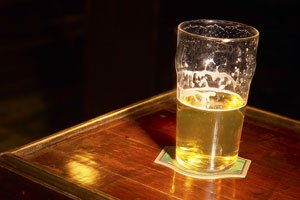Most people know that it takes yeast to make beer, and some
people know a little bit about how it performs that miracle.
Most people know that it takes yeast to make beer, and some people know a little bit about how it performs that miracle. But probably few people besides brewers and biochemists are familiar with the intricate series of seemingly unrelated chemical reactions that must occur in a particular order – from long before the yeast does its magic – to turn ordinary grain and water into the delicious and mildly alcoholic carbonated concoction so many of us enjoy.
Here is a step-by-step primer on the natural science of brewing. You might wish to pop open a tall, cool, smooth one to further appreciate the marvelous result of the art we have made of that science.
From barley to brew: step-by-step
1. Malting: “Malting” is the controlled germination of barley. After steeping the barley in water, the grain is spread on a malting floor and allowed to grow until it is modified. During this time, natural enzymes transform the endosperm from complex to simple starches. The grain is dried at high temperatures and milled.
2. Mashing: Astonishingly, drying sprouted grain at temperatures high enough to destroy its life force does not destroy its ability to produce momentous chemical activity. Bringing the “mash” to between 148 and 158 degrees activates a pair of related enzymes that liquefy and reduce the now-soluble starches into maltose and other simple sugars.
3. Lautering: Once all reducible starches have been converted, the mash is heated yet again, to 170 degrees. The liquid is drawn off through a filter bed of the remaining husks of the original grain. The husks are then rinsed (“lautered”) thoroughly with more hot water. All the runoff from the mash is known as “wort,” and it constitutes what will become the finished beer.
4. The boil: Achieving clear beer with a firm, foamy head is largely a function of removing most – but not quite all – proteins from the original mash. Proteins, when boiled, will coagulate and settle out of the liquid, forming a gummy mass called “trub.” This action is called the “hot break.” Boiling is also necessary to extract important flavoring agents, called alpha acids, from hops. Up to a point, the longer the wort is boiled, the more efficiently a given amount of hops can bitter a quantity of beer. Boiling even longer can produce caramelization of sugars in the wort.
5. The cold break: As soon as the boil is complete, the wort is quickly cooled. This precipitates even more undesirable proteins and tannins out of the wort. This time the process is called the “cold break,” and the residue is called “cold trub.”
The fermentation cycle
Pitching the yeast: Perhaps the most important key to making good beer is to keep wild yeast and bacteria from gaining a foothold in your brew before the preferred yeast does. This is done through good sanitation and proper “pitching” of a sufficient quantity of carefully cultivated beer yeast. When the wort is cooled, a thick broth of cultivated yeast is added.
1. The lag phase: The yeast immediately begins to absorb oxygen. Enzymes facilitate yeast’s intake of glucose, more complex sugars and other nutrients. All this takes place within a few hours.
2. The respiration and fermentation phases: With sufficient food reserves stored away, the yeast begins to reproduce by “budding.” It absorbs all the remaining oxygen in the wort and uses it and the various other nutrients to produce new “daughter” cells. Once all oxygen is absorbed, reproduction halts and fermentation proper begins. In a simplified explanation, yeast turns one molecule of glucose into two molecules each of ethyl alcohol and carbon dioxide.
Clarifying and carbonation: Once all available fermentable sugars are consumed, fermentation grinds to a halt and the yeast begins to go dormant. The beer is clarified by storing in a cool, still, sterile environment. It is now nearly free of clouding agents and is clear. It is also flat. During the whole fermentation process, the huge amount of carbon dioxide produced has been allowed to escape through a gas vent, while the alcohol has been preserved in an otherwise closed environment. To achieve carbonation, brewers inject carbon dioxide to the desired level.
Something to sip on: Intriguing facts about beer
– Beer was brewed from barley at least 7,000 years ago. But only lately have we discovered that barley, among all grains, is so rich in enzymes that it can convert to sugars not only its own starches but up to its own weight in additional starches. This is grandly referred to as “diastatic power” and accounts for the ability of large brewers to brew beer from up to 50 percent corn (Miller, et al.) or rice (Budweiser). Those grains do not contain, on their own, the necessary enzymes to convert starches to cleanly fermentable sugars. They need help. Barley provides.
– In ancient Mesopotamia and Egypt, laborers were paid in beer. Gigantic bakeries produced huge quantities of bread, which was not distributed. Rather, the loaves of bread were dissolved in water and turned into beer.
– We like to think that the brewing art and science have been perfected only recently, but even in ancient times, certain brewers were recognized for their talents. Many of them had hereditary status. Their secret: They used wooden bowls and spoons handed down through generations. The secret of that: Yeast cells are very hardy and can survive dormancy in many extreme conditions and habitats. One that they are especially well adapted to is the grain of wood. The spoons and bowls of ancient brewers harbored unique strains of good brewing yeast that were reconstituted with every use.
– The Pilgrims were aiming for Virginia but got off course. When they landed in the uninviting region of New England, they begged the crew of the Mayflower to take them south. The crew demurred. They were running out of beer. They left the Pilgrims to their fate, and half died before they managed to establish a sufficient brewing regimen, mostly from pumpkins. The lesson: Don’t drink the water. No known disease pathogen can survive in even weak beer.














